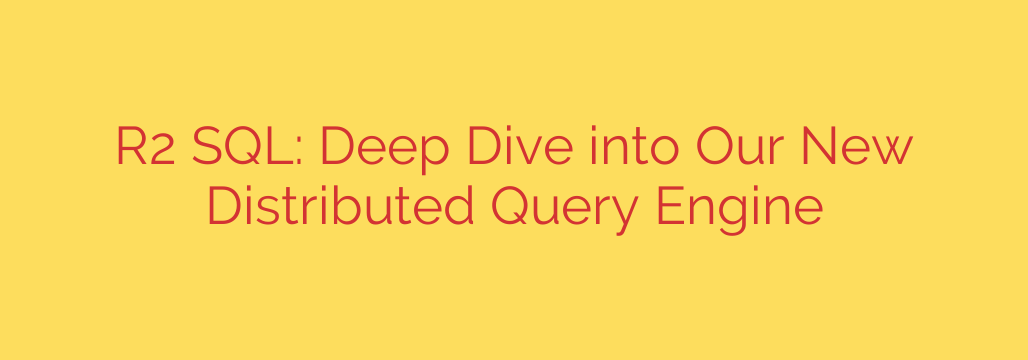
Unlocking Your Data: How to Run SQL Queries Directly on Object Storage
For years, the world of data analytics has been defined by a familiar, often cumbersome, process: the ETL pipeline. Data is generated and lands in affordable object storage, but to analyze it, you must first Extract it, Transform it into a usable format, and Load it into a specialized data warehouse. This multi-step process is not only complex and slow but also incredibly expensive, involving data duplication, costly egress fees, and the high price of warehouse compute power.
But what if you could bypass this entire pipeline? A revolutionary approach is emerging that allows you to run powerful, interactive SQL queries directly on your data right where it lives—in object storage. This paradigm shift is set to fundamentally change how we approach data analytics.
The Old Way: The Problem with Traditional Data Pipelines
In a typical analytics setup, object storage acts as a massive data lake—a cost-effective repository for raw data formats like JSON, CSV, and Parquet. However, these data lakes have historically been “query-dark,” meaning you couldn’t directly analyze the information within them.
To get answers from your data, you had to:
- Build and maintain a complex ETL/ELT pipeline using tools like Spark, Flink, or custom scripts.
- Pay to move the data out of object storage (incurring egress fees) and into a data warehouse like BigQuery, Snowflake, or Redshift.
- Pay again for duplicated storage in the warehouse.
- Finally, pay for the compute resources within the warehouse to run your SQL queries.
This architecture is brittle, expensive, and introduces significant latency. By the time your data is ready for analysis, it might already be hours or even days old.
A New Paradigm: The Distributed SQL Query Engine
Imagine a powerful, distributed query engine built to operate directly on top of your existing object storage. This is no longer a futuristic concept but a present-day reality. This new model allows you to run standard SQL queries on your files without moving them anywhere.
Here’s how it works: Instead of pulling data into a separate system, the query engine intelligently scans the data where it resides. It’s a serverless, distributed system that can process terabytes of information in parallel, delivering answers in seconds.
Key features of this approach include:
- Standard SQL Interface: You can use a familiar, SQLite-compatible SQL syntax to query your data, making it accessible to any analyst or developer with basic SQL knowledge.
- Support for Open Formats: The engine is designed to work seamlessly with the file formats you already use, including Parquet, CSV, and JSON. This means you aren’t locked into a proprietary format and can maintain a flexible, open architecture.
- No Data Movement Required: The core innovation is querying data “in-situ.” This single change eliminates the primary costs and complexities associated with traditional data warehousing.
The Transformative Benefits of Querying In-Place
Adopting a direct query model for object storage isn’t just an incremental improvement; it’s a game-changer that offers profound advantages.
1. Dramatically Reduced Costs
By eliminating the need for a separate data warehouse and data transfer, the cost savings are substantial. You no longer pay for data duplication, egress fees, or idle warehouse clusters. Instead, you pay only for the specific queries you run, making sophisticated analytics accessible and affordable.
2. Radically Simplified Architecture
No more complex ETL pipelines. This is the most significant architectural benefit. Your data pipeline simplifies to a single step: data lands in object storage, and it’s immediately available for querying. This reduces engineering overhead, eliminates points of failure, and allows your team to focus on generating insights, not managing infrastructure.
3. Instant, Real-Time Insights
Latency is a major bottleneck in traditional analytics. With a direct query engine, your data is “hot” and ready for analysis the moment it’s written. This enables real-time dashboards, immediate operational intelligence, and faster decision-making without waiting for nightly batch jobs to complete.
4. Unprecedented Flexibility and Performance
This architecture leverages the power of distributed computing to deliver impressive performance. Smart query planning, predicate pushdown (filtering data at the source), and optimizations for columnar formats mean that even complex analytical queries can be executed quickly. You get the flexibility of a data lake with the performance of a data warehouse.
Actionable Advice: How to Maximize Performance
To get the most out of this powerful new model, follow these best practices for organizing your data in object storage:
Embrace Columnar Formats: For analytical workloads, using a columnar format like Parquet is highly recommended. Unlike row-based formats (like CSV or JSON), Parquet stores data in columns, allowing the query engine to read only the specific columns needed for your query. This drastically reduces the amount of data scanned, leading to faster queries and lower costs.
Partition Your Data: Organize your data into a logical folder structure, often by date or another high-cardinality attribute (e.g.,
/logs/year=2023/month=12/day=15/). This allows the query engine to perform “partition pruning,” where it can completely skip scanning files in irrelevant folders. A query for a specific day won’t waste time scanning data from other months or years.Secure Your Foundation: While the query engine is new, the underlying security principles of object storage remain critical. Ensure you have robust access control policies (like IAM roles) in place to govern who can read and write data. Treat your object storage as the secure foundation of your entire data strategy.
By adopting these strategies, you can build a highly efficient, scalable, and secure analytics platform that delivers insights faster and at a fraction of the cost of traditional methods. The era of the expensive, slow data warehouse is giving way to a more agile, cost-effective future—one where your data lake is no longer dark, but brilliantly illuminated with insight.
Source: https://blog.cloudflare.com/r2-sql-deep-dive/








